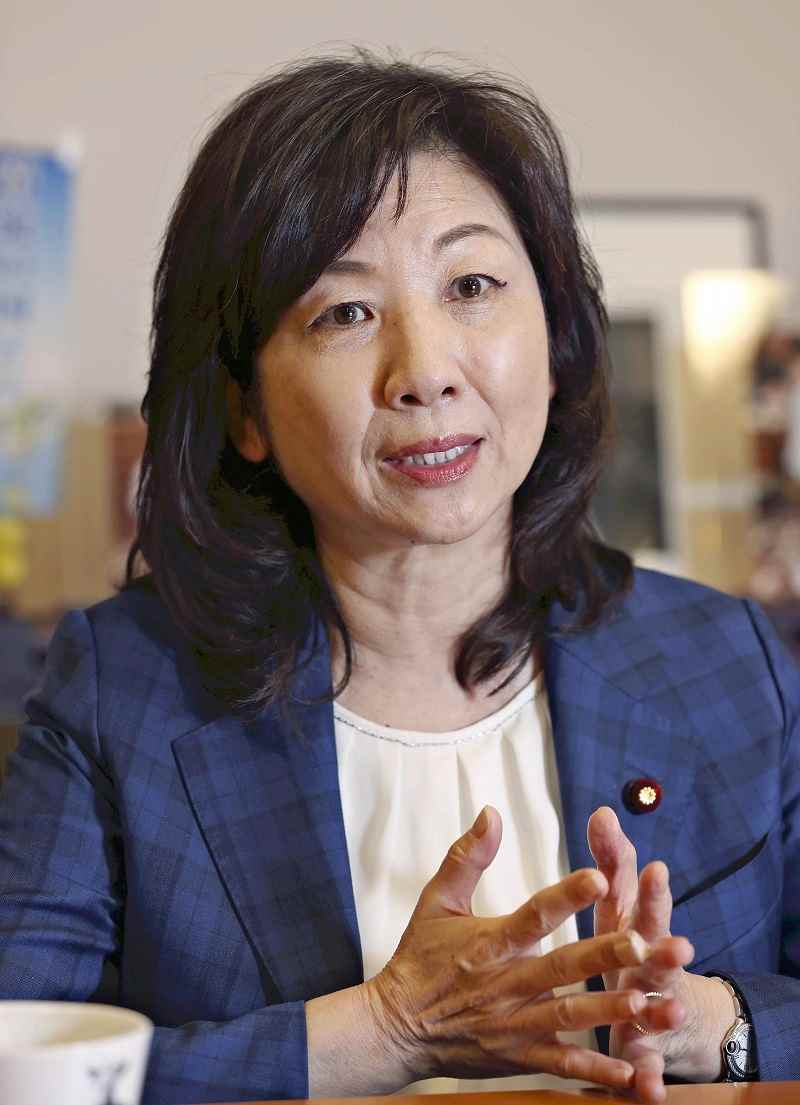LDP executive acting secretary general : Still difficult to get women, new candidates involved in politics in Japan

LDP Executive Acting Secretary General Seiko Noda speaks during an interview in Tokyo on May 9.
12:09 JST, June 24, 2021
This is the fourth installment of a series reflecting on the single-seat constituency system over the last 25 years. The following is excerpted from an interview with the ruling Liberal Democratic Party’s Executive Acting Secretary General Seiko Noda.
The Yomiuri Shimbun: The number of female lawmakers has not increased significantly even after a system that combines single-seat constituencies and proportional representation was introduced for House of Representatives elections.
Noda: From my point of view, as a person who has experienced running under the multi-seat electoral system, the single-seat constituency system has its successes and failures. In the multi-seat constituency system, women were not given priority as many incumbent men from the LDP contested in one constituency. There was a sense of crisis among women that they might end up being used as mascots and not get much work, even if they were elected. I felt that such a multi-seat constituency system would derail female lawmakers.
On the other hand, I thought if women were elected in single-seat constituencies and captured the constituency as the sole winner, they would be able to have the same power as male Diet members without discrimination. So I promoted the introduction of the single-seat constituency system. In fact, after the introduction of the system, activities of lawmakers are no longer compromised simply because they are women.
However, what I failed to reckon was that because each party officially endorses only one candidate per constituency, the number of people who can’t become party-backed candidates has increased. Under the multi-seat constituency system, there was an environment where one or two newcomers could run even though an incumbent ran in the electoral district. However, in a single-seat constituency, as long as an incumbent vies for a seat, it is difficult for first-time or never-elected candidates to obtain official endorsement from their party. It has become difficult to bring in new candidates regardless of gender.
Women especially are facing difficulties in becoming party-endorsed candidates. In the case of the LDP, its regional organizations take the lead in selecting candidates for single-seat constituencies, but the number of women in local assemblies remains low, and the organizations themselves have been dominated by men. Given that, men tend to be chosen after the organizations narrow down the candidates.
Q. What should be done to increase the number of female lawmakers?
A. The current situation won’t change unless women are proactively recruited through decisions coming from the top down. If it’s still difficult for women to run in single-seat constituencies, I want to suggest getting their names on the party’s proportional representation list. In any case, the first step to raising the number of female Diet members is to enable them to become candidates and get involved in the local community.
Currently, the LDP has a political academy for women aspiring to enter politics called Women’s Future Leadership Program, where I serve as its head. I think it would make a big difference if we make a list of those participating in the academy and let the party’s prefectural chapters know that there are possible candidates in their areas.
Q. As a former internal affairs and communications minister in charge of the electoral system, how do you see the current situation?
A: The electoral system that combines single-seat constituencies and proportional representation was initially aimed at bringing about a two-party system, but such a system didn’t take root. We now have a political system in which one party is strong and many others are weak, with the LDP standing out. I feel that opposition parties have fallen apart and not been able to take advantage of the single-seat constituency system fully. Without a strong rival, the LDP also lacks a sense of urgency and has been mired in a series of scandals. This is not a healthy situation at all.
The current LDP doesn’t have the vitality it once had. When the multi-seat constituency system was in place, the leaders of each party faction fought with each other to expand their clout and this was the driving force for the party. Under the single-seat constituency system, the power of the party leaders has become too strong, creating an environment that makes it difficult for party members to express diverse opinions. I’m concerned that this may lead to the deterioration of policies.
Some people argue that it has become difficult for people in regional areas to have their opinions heard by the central government, but this is not true. Single-seat constituencies have Diet members across the nation. However, nowadays, one lawmaker is tasked with listening to all the voices of the constituency, whether the matters are about agriculture, welfare or education. So I think the number of Diet members acting in the interest of specific industries has decreased.
It is difficult for voters to understand the current electoral system in which a candidate who lost in a single-seat constituency can be elected under a proportional representation scheme. Although the single-seat constituency system is designed to select one candidate from each constituency, there have been cases in which three candidates ended up being elected in the constituency. I had the experience of losing in a single-seat constituency but winning a Diet seat through proportional representation in the 2009 lower house election. At that time, it was awkward to work as a lawmaker because I felt as if I wasn’t given recognition by the voters.
If possible, I want the current system in which candidates can be elected in proportional representation blocs even though they lost in single-seat constituencies to be overhauled by not allowing double candidacy in single-seat and proportional representation races. By doing so, I believe parties can better convey public opinions by listing various candidates for the proportional representation segment. That could also lead to an increase in the number of female Diet members.
—This interview was conducted by Yomiuri Shimbun Staff Writer Ryuichi Sato.
Seiko Noda, 60, LDP executive acting secretary general
Noda graduated from Sophia University in Tokyo. After serving as a member of the Gifu Prefectural Assembly, she was first elected to the House of Representatives from the former Gifu No. 1 Constituency in 1993 when a multi-seat constituency system was in place. In 1998, she was appointed posts and telecommunications minister at the age of 37. Noda left the LDP in 2005 after opposing the privatization of postal services. Since returning to the party the following year, she has assumed such party and government posts as the LDP’s general council chair and internal affairs and communications minister. Noda started in her current post in September 2020. She has been elected to the lower house nine times.
"Politics" POPULAR ARTICLE
-

Japan to Support Central Asian Logistics Route That Bypasses Russia, Plan to Be Part of Upcoming Summit in Tokyo
-

Japan to Tighten Screening of Foreigners’ Residential Status by Providing Information of Nonpayment of Taxes
-

Chinese, Russian Bombers Flew Unusual Path by Heading Toward Tokyo; Move Likely Meant to Intimidate Japan
-

Japan Plans National Database to Track Foreign Ownership of Real Estate, Land as It Weighs New Rules
-

Up to 199,000 Deaths Estimated From Mega-Tsunami; Most Recent Occurrence Took Place in 17th Century
JN ACCESS RANKING
-

Tokyo Economic Security Forum to Hold Inaugural Meeting Amid Tense Global Environment
-

Keidanren Chairman Yoshinobu Tsutsui Visits Kashiwazaki-Kariwa Nuclear Power Plant; Inspects New Emergency Safety System
-

Imports of Rare Earths from China Facing Delays, May Be Caused by Deterioration of Japan-China Relations
-

University of Tokyo Professor Discusses Japanese Economic Security in Interview Ahead of Forum
-

Japan Pulls out of Vietnam Nuclear Project, Complicating Hanoi’s Power Plans



-250x167.jpg)






















